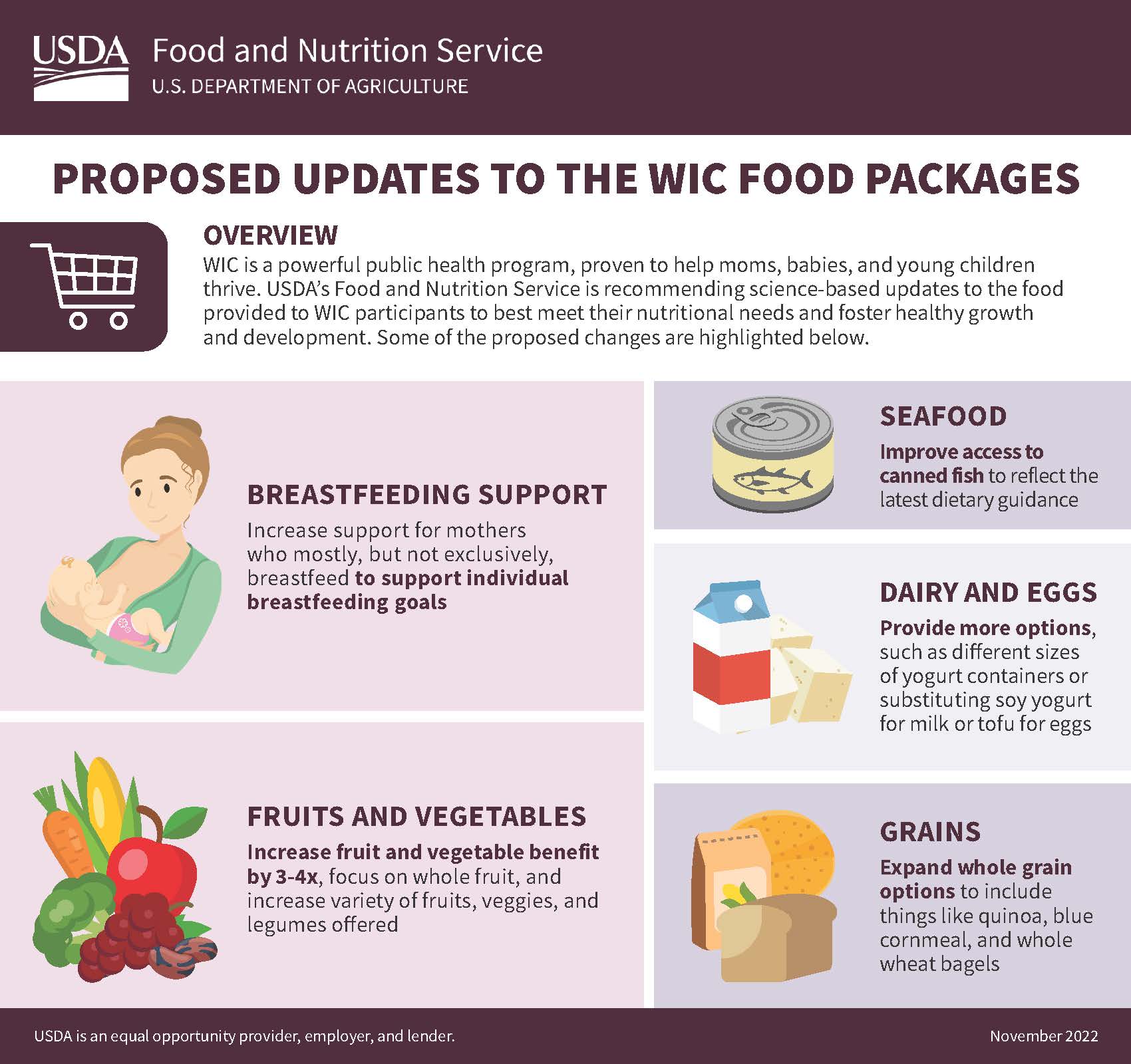
Share On Social!
You can comment now on the USDA’s new proposed revisions to the Special Supplemental Nutrition Program for Women, Infants, and Children (WIC) food packages that aim to improve nutrition and promote and support breastfeeding.
Proposed changes, based on scientific recommendations from a 2017 report from the National Academies of Sciences, Engineering, and Medicine, include:
- Enhanced buying power for fruits, vegetables.
- Increased foods consumed less in adequacy, amount.
- More options for cultural eating patterns.
- Ability to get the quantity of formula to support any level of breastfeeding.
- Requiring all breakfast cereals to meet the whole grain-rich standards that already apply to school nutrition programs and the Child and Adult Care Food Program.
USDA is seeking comments on the changes.
We at Salud America! partnered with UnidosUS to create the following model comment you can use to support the new WIC changes, which can improve nutrition among Latino families.
Comment now in English by Feb. 21, 2023!
Comment now in Spanish by Feb. 21, 2023!
Submit This Model Comment to Support the WIC Food Changes:
WIC is one of the nation’s most successful, cost-effective public health nutrition programs.
WIC participants, including the 40% who are Latino, are more likely to have a more nutritious diet and better health outcomes (https://salud.to/betterhealthoutcomes), with participation tied to fewer infant deaths, fewer premature births, increased birth weights, and lower health care costs.
Still, Latino children and families continue to experience inequitable access to food and disparities in diet-related illnesses. Compared to non-Hispanic Whites, Latinos are more than twice as likely to suffer from type 2 diabetes. Between 2013-2016, Latino children were 1.8 times more likely to be obese compared to non-Hispanic white children (https://salud.to/obesitynumbers). The rate of food insecurity among Latino households (16.2 percent) is significantly higher than the national average of 10.2 percent (https://salud.to/foodnumbers).
Improving the food package for WIC by including the recommendations of the National Academies of Sciences, Engineering, and Medicine (NASEM) in the proposed rule changes will improve the health of low-income Latino families.
We are particularly supportive of steps to ensure that breakfast cereals purchased by WIC dollars meet the same whole grain-rich standards that now apply to school nutrition programs and the Child and Adult Care Food Program. Evidence shows that increasing consumption of whole grain cereals can significantly lower diabetes and obesity rates. This happened the last time WIC nutrition standards were upgraded in 2009, requiring half of WIC cereal products to meet whole grain-rich standards. This gave Latino parents additional options, with WIC supplementing the foods that families could buy using other resources. When the WIC national standard improved, Latino parents purchased the new healthier options, and Latino children rapidly experienced notable gains, including a 17% increase in fiber intake and a 10% decrease in the prevalence of childhood obesity among Latino toddlers enrolled in WIC. This is critical for Latinos, who maintain the country’s lowest average daily consumption of whole grains.
If the WIC package is improved to incorporate the NASEM recommendations, all WIC-participating grocery stores will be required to offer shoppers the choice to buy whole grain-rich cereals. This will bring healthier food options to low-income, Latino neighborhoods throughout America, benefiting WIC participants and other families alike.
What is WIC?
WIC is a federal food and nutrition program run by the USDA.
The program provides access to specific foods, as well as nutrition education and health and social service referrals, for low-income infants, children up to age 5, and women who are pregnant, breast-feeding, or postpartum.
WIC food “packages” allow participants to obtain foods that provide specific nutrients for pregnancy, growth, and development.
“More than 6.2 million women, infants, and children participate in WIC. More than 40% of them are Hispanic/Latino, which makes WIC an important tool to advance health equity,” according to a blog post by USDA Deputy Under Secretary Stacy Dean and Dr. Amelie Ramirez, Director of the Salud America! program at UT Health San Antonio.
Why is WIC Being Updated?
Foods offered through WIC must align with the current Dietary Guidelines for Americans, which are revised every five years.
An evaluation of the WIC food packages is congressionally mandated every 10 years.
That is why the USDA sought scientific recommendations from the National Academies of Sciences, Engineering, and Medicine (NASEM) for the proposed changes.
NASEM revealed its WIC revision recommendations in a 2017 report.
The report recommended adding fish, increasing the amount of whole grains, increasing vegetables and fruits as a trade-off for decreasing juice, milk, legumes, peanut butter, infant vegetables and fruits, and infant meats.
“Our report leaves most aspects of the current food packages unchanged, but a few foods have been added or amounts adjusted to enhance their quality for participants,” said Kathleen Rasmussen, a report author of Cornell University, in a 2017 NASEM news release. “The proposed revisions provide better adherence to the Dietary Guidelines for Americans, are more consistent with the standards of other nutrition assistance programs and increase flexibility and choice for participants.”
What Does the Science Say about the Proposed WIC Rule Changes?
The 2017 NASEM report had these major recommendations:
- Increase the value of the voucher participants use to buy fruits and vegetables.
- Increase foods currently provided in lower amounts or consumed less adequately – such as whole grains, vegetables, fruits, and fish.
- Decrease foods that already provided at least 100% of the recommended intake of several nutrients and food groups – such as juice, dairy, peanut butter, legumes, and infant foods.
- Offer options to support cultural eating patterns: substitute a voucher in place of juice, different forms and varieties of vegetables and fruits, both canned and dried legumes, and a range of options and sizes for grains and yogurt.
- Mandate all bread be 100 percent whole wheat, yogurt contain no more than 30 grams of total sugars per 8 ounces, soy beverage contain no more than 12 grams of total sugars per 8 ounces, and only unflavored milk be permitted.
- Enable women to get the quantity of formula needed to support any level of breast-feeding (partial or exclusive).
The changes would also require all breakfast cereals to meet the whole grain-rich standards that already apply to school nutrition programs and the Child and Adult Care Food Program.
 Thus, all WIC-participating grocery stores would offer shoppers the choice to buy whole grain-rich cereals, which means “healthier food options to low-income, Latino neighborhoods throughout America, benefiting WIC participants and other families alike,” according to a Sept. 21, 2022, letter from UnidosUS and the Hispanic Federation to USDA Secretary Tom Vilsack.
Thus, all WIC-participating grocery stores would offer shoppers the choice to buy whole grain-rich cereals, which means “healthier food options to low-income, Latino neighborhoods throughout America, benefiting WIC participants and other families alike,” according to a Sept. 21, 2022, letter from UnidosUS and the Hispanic Federation to USDA Secretary Tom Vilsack.
“Latino parents care about their children getting the best nutrition possible to give them a healthy start in life. Once healthier options become available and parents learn about their value, Hispanic parents choose what is best for their children,” according to the letter.
“This happened the last time WIC nutrition standards were upgraded in 2009, requiring half of WIC cereal products to meet whole grain-rich standards. This gave Hispanic parents additional options, with WIC supplementing the foods that families could buy using other resources. When the WIC national standard improved, Latino parents purchased the new healthier options and Hispanic children rapidly experienced notable gains, including a 17% increase in fiber intake and a 10% decrease in the prevalence of childhood obesity among Hispanic toddlers enrolled in WIC.”
What Are the Next Steps for the WIC Food and Nutrition Revisions?
Several Latino- and health-focused organizations have voiced support for the proposed WIC nutritional improvements, including the change in breakfast cereals.
On Sept. 21, 2022, UnidosUS and the Hispanic Federation sent a letter to USDA Secretary Tom Vilsack urging implementation of the science-based recommendations for the WIC changes.
On Sept. 16, 2022, a similar letter of support was sent to Vilsack from the Academy of Nutrition and Dietetics; American College of Obstetricians and Gynecologists; American Heart Association; American Public Health Association; Association of State Public Health Nutritionists; Bread for the World; Center for Science in the Public Interest; Food Research & Action Center (FRAC); First Focus on Children; Latinos and Hispanics in Dietetics and Nutrition; National WIC Association; Nemours Children’s Health; and Trust for America’s Health.
On Nov. 1, 2022, the Congressional Hispanic Caucus and Congressional Asian Pacific American Caucus also submitted a letter of support to Vilsack.
“We are confident that the thoughtful, comprehensive approach of the NASEM review will positively contribute to the dietary quality of our communities and ensure that parents from Hispanic, AANHPI, and other communities of color have the resources and support to secure future life success for their children,” according to the letter.
You can submit a public comment, too.
The current comment period will end on Feb 21, 2023. After this 90-day comment period, the USDA will review the comments and determine how to move forward.
“We applaud USDA’s thoughtful steps to strengthen WIC by enhancing the value of benefits for under-consumed food groups like fruits and vegetables, strengthening nutrition standards to improve whole grain intake and decrease consumption of added sugars and saturated fats, and expanding healthy choices through package size flexibility and inclusion of a broader range of cultural foods. We strongly urge our members and the broader WIC and public health communities to actively engage in the comment process as we build a healthier future for America’s next generation,” said Dr. Jamila Taylor, President and CEO of the National WIC Foundation in a press release.
A press release from the USDA further reports of how the proposed changes promote nutrition security, maternal and child health, and increase flexibility for participants.
“WIC remains one of the nation’s most successful, cost-effective public health nutrition programs. WIC participants, including those who are Hispanic/Latino, are more likely to have a more nutritious diet and better health outcomes, with participation tied to fewer infant deaths, fewer premature births, increased birth weights, and lower health care costs, according to research,” said Dr. Amelie Ramirez, Director of Salud America! at UT Health San Antonio said in a press release.
By The Numbers
20.7
percent
of Latino kids have obesity (compared to 11.7% of white kids)



